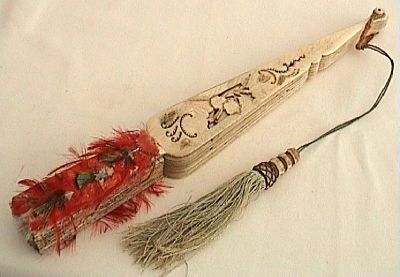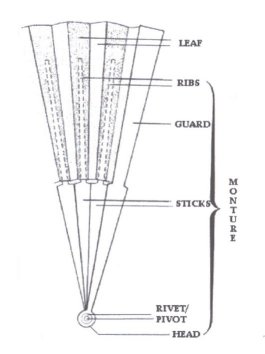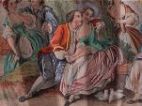 Fans are Oriental in origin and have been known for over 3000 years. Few art forms combine functional, ceremonial and decorative uses as elegantly as the fan. Fewer still can match such diversity with a history stretching back over many thousands of years.
Fans are Oriental in origin and have been known for over 3000 years. Few art forms combine functional, ceremonial and decorative uses as elegantly as the fan. Fewer still can match such diversity with a history stretching back over many thousands of years.This article is only intended to be a brief history and introduction to fans. For those wanting to explore further, reference should be made to museum collections and the various books devoted to the subject to gain specialist knowledge.
Pictorial records of the earliest fans date from around 3000 BC and there is evidence that both the Greeks and the Romans used fans as cooling, and ceremonial devices, whilst Chinese literary sources associate the fan with ancient mythical and historical characters. Originally fans had purely practical functions - to keep the user cool, to fan the flames of the fire or to ward of flies. It was not long however before they began to acquire ritual and social significance. Fans were an essential part of social etiquette - ladies would use them to flirt behind or to indicate pleasure or approval.
Early fans were all of the fixed type, and the folding fan does not appear either in the East or the West until relatively late in its history.

Fan Anatomy
The folding fan, which was probably Japanese in origin, made a fan highly portable since it could be folded away and slipped into a sleeve, pouch or bag. The fan had delicate ivory sticks and leaves of paper, leather or white kid delicately painted with classical and mythological scenes. The early European folding fans were reserved for Royalty and the nobility and, as expensive toys; they were regarded as a status symbol.

Fan Sticks
From about 1725 mass-produced fans were made with printed leaves, which were often poor in design and colouring. From 1750, fans printed with advertising messages were produced. By the end of the 1700’s with the cheaper printed ones in production, fans were available to every strata of society in Europe.

Duvelleroy Fan
Novelty fans were produced as early as the 1700’s. Double image fans from around 1750 have three or four different scenes, and when the fan is opened the wrong way from right to left, a hidden scene is revealed. There are also spy hole fans, fans with carved handles and telescopic fans, parasol fans and collapsible fans.

Duvelleroy Fan
During the 1800’s along with its early political turmoil, fans again reflected the times. The Great Exhibition of 1851 marked the watershed for fan production, bringing it into modern times with patented inventions and a renewal of interest in fine materials and painting. Many fans from 1850 onwards are signed but often by little know decorative artists. However some very fine fans were produced in the 1860’s to 1890’s by artists such as A. Solde and Callamatta Billotey who painted fine fan mounts on silk gauze for the well-known fan makers Duvelleroy. In the 1890’s Duvelleroy produced very fine double-sided fans depicting romantic subjects for the British market. The pictures in this article illustrate one such example of a Duvelleroy fan from this period. From the 1850’s to 1890’s some very fine lace fans were produced with mainly Honiton, Brussels and Chantilly lace.

Hand Painted Romantic Scene
Fans again mirrored the social and economical times in the 1900’s, with the rise of advertising, and a more utilitarian and wasteful society. Spain is now the only European country where a fan is still part of everyday life. Fans still remain in use in most hot countries particularly in the Far East, and especially in Japan.
